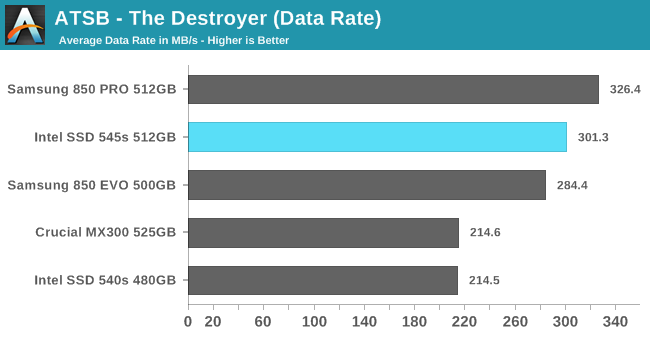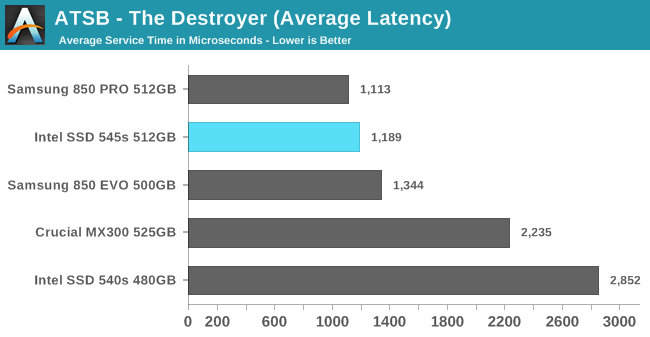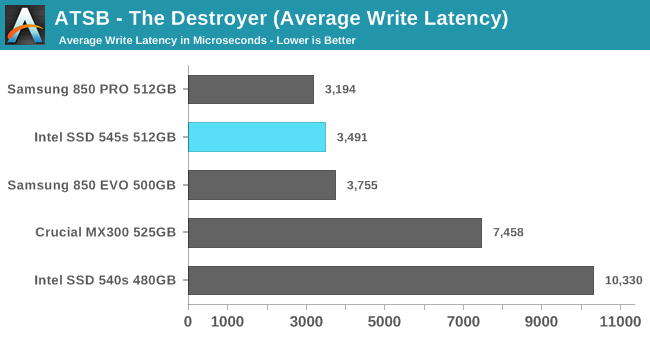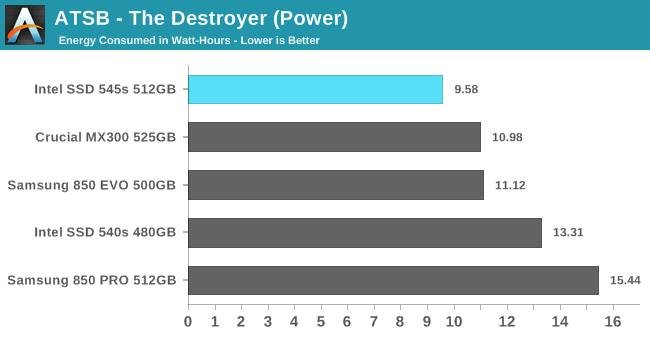The Intel SSD 545s (512GB) Review: 64-Layer 3D TLC NAND Hits Retail
by Billy Tallis on June 27, 2017 6:00 AM ESTAnandTech Storage Bench - The Destroyer
The Destroyer is an extremely long test replicating the access patterns of very IO-intensive desktop usage. A detailed breakdown can be found in this article. Like real-world usage, the drives do get the occasional break that allows for some background garbage collection and flushing caches, but those idle times are limited to 25ms so that it doesn't take all week to run the test. These AnandTech Storage Bench (ATSB) tests do not involve running the actual applications that generated the workloads, so the scores are relatively insensitive to changes in CPU performance and RAM from our new testbed, but the jump to a newer version of Windows and the newer storage drivers can have an impact.
We quantify performance on this test by reporting the drive's average data throughput, the average latency of the I/O operations, and the total energy used by the drive over the course of the test.

The Intel SSD 545s performs surprisingly well on The Destroyer, with an average data rate that surpasses the Samsung 850 EVO and potentially makes the 545s the new fastest SATA SSD with 3D NAND. The 3D MLC-based Samsung 850 PRO is still out of reach, but the 545s is a big improvement over the 540s and the Crucial MX300.

The Intel 545s also ranks between the Samsung 850 PRO and 850 EVO in terms of average latency, with slightly more than half the latency of the Crucial MX300 and an even wider margin over the Intel 540s.


Separating the latency according to reads and writes, we see that the 545s is much closer to the Samsung 850 PRO than the 850 EVO for reads. The write latencies of the Samsung drives and the 545s are all much lower than the Crucial MX300 or Intel 540s.

In addition to delivering great performance for a SATA TLC SSD, the Intel 545s brings a huge improvement in power efficiency. The 545s uses 12% less energy than the Crucial MX300 or Samsung 850 EVO over the course of the test. Only a few SSDs have ever completed The Destroyer on such a small energy budget, and only one other TLC SSD has been this efficient.










74 Comments
View All Comments
cybertec69 - Tuesday, June 27, 2017 - link
There is no NANDI shortage, it's all a bunch of nonsense, it's nothing more than price gouging.patrickjp93 - Wednesday, June 28, 2017 - link
Yes there is. Factories are converting all of their equipment from planar to 3D. It takes time just to move everything, then tune yields, and boost to mass production. On top of that, NAND demand has doubled in the past 2 years. There is a very real shortage.AnTech - Wednesday, June 28, 2017 - link
How does it compare to the current gold standard (Samsung Portable SSD T3)?Samsung Portable SSD T3 is so amazing that keeps cold even when booting Mac and working from it all day long. Really remarkable and amazing!
BTW, bring much larger sizes of 4 TB and more! And much cheaper prices!
Hurr Durr - Wednesday, June 28, 2017 - link
>portable ssd>gold standard
In what, waiting for the file transfer to finish?
mayankleoboy1 - Wednesday, June 28, 2017 - link
Regarding the "Random read performance" metric as outlined in http://www.anandtech.com/show/9009/ocz-vector-180-...Do you think it makes more sense to give 50%:37.5:12.5% weights to QD1:QD2:QD4 , instead of taking simple average?
Doubleslash - Wednesday, June 28, 2017 - link
Can you please do some meaningful IOPS, bandwidth and latency tests with fio or iozone? Things like sustained random 4k/8k/16k IOPS and large-block (64k/256k/512k/1024k) sequential read and write throughput are much better suited to compare wear-leveling, cache and controller performance.You can omit these SYSmark test as they are pretty useless. As the result indicates they do not stress the disk subsystem very much.
jardows2 - Wednesday, June 28, 2017 - link
Reviewing these charts, this product falls between the EVO and the MX300, but only slightly better than the MX300. It appears that the only realistic differences between the 545 and the MX300 are seen when the MX300 is full. Who uses their drives full? The current $20 price premium of the 545 over the MX300 doesn't seem worth it for the small gains, unless Intel can improve performance with some firmware updates.Wolfpup - Wednesday, June 28, 2017 - link
Wish companies would release MLC if not SLC drives too... Really not excited about being stuck with TLC.And I'm YEARS past caring about the performance of any of these drives, unless there's something weird about them. I care about reliability.
Hell, a few of my systems (not main systems, but still) boot if 5400RPM mechanical drives, and are fine. I really don't care if word launches in 0.0001 seconds or 0.0002 seconds or whatever LOL
piiman - Saturday, July 22, 2017 - link
"I really don't care if word launches in 0.0001 seconds or 0.0002 seconds or whatever LOL"Blasphemy!
alpha754293 - Thursday, June 29, 2017 - link
I look forward to seeing how it performs on the random write tests...I have four Intel 540 series 1 TB SSD drives at home and they're ok. I traded off speed for capacity and cost, and I didn't know that this was launching, so this was sort of a welcomed surprise.